Home » Firearms and Shooting » Shotguns » 16-Gauge Shotguns – Selection, Ballistics, History, and More
16-Gauge Shotguns – Selection, Ballistics, History, and More
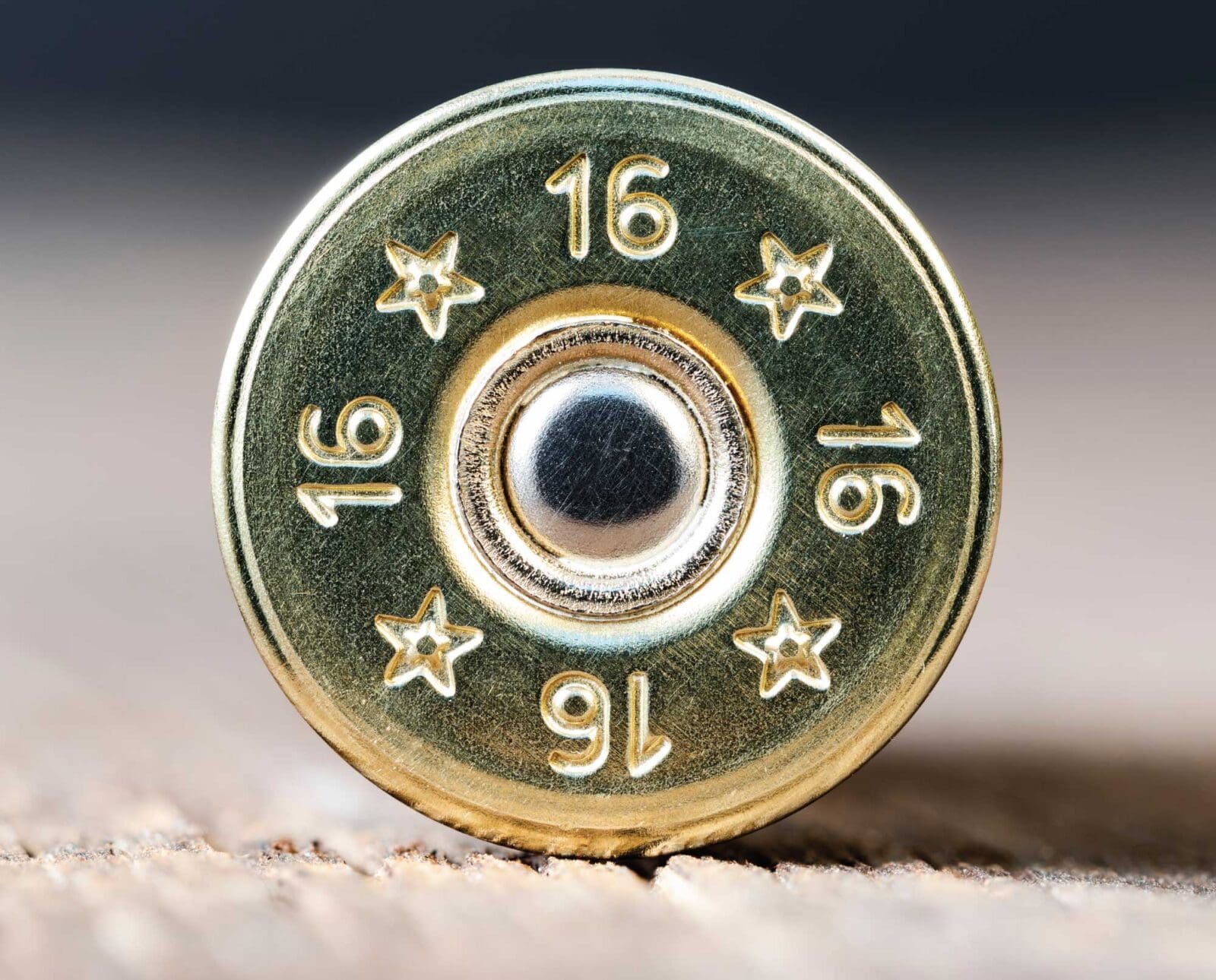
A.J. DeRosa, founder of Project Upland, is a New England…
Take a look at the history, culture, and current offerening of 16-gauge shotguns
One of history’s most famous 16-gauge shotguns was known as “The Little Gun.” It was built by Parker Bros in 1889 and “was billed to Mr. D. W. Parker, then treasurer of the Parker Company.” In 1893, it went to Everel Harnden, the grandfather of the famous “godfather” of ruffed grouse hunting, William Hardnen Foster. Foster would shoot his first grouse on the wing with it at 12 years old in 1898 before he went on to write the iconic classic, New England Grouse Shooting, published in 1942.
Listen to more articles on Apple | Google | Spotify | Audible
For the most part, the 16-gauge probably garnered its popularity in the United States by pellet counts. Classic American manufacturers like Parker Bros, A.H. Fox, L.C. Smith, and others helped the gauge gain familiarity and popularity. The gauge peaked in American culture in the 1940s and 1950s when almost a quarter of all shotguns sold were 16-gauges. The 12-gauge accounted for just over 50 percent of shotguns sold at that time, according to author Layne Simpson of Shotguns & Shotgunning.
In the 2023 North American Upland Hunting Survey, the 16-gauge came in as the fourth most popular gauge, with 10.63 percent of modern upland hunters citing it as their preferred gauge. It was bested by the third-place 28-gauge by only half a percent. Among Millenials, it is the third most popular gauge, beating out the 28-gauge.
After researching this gauge, it’s hard to make a solid case for what came first — the chicken or the egg. Was it shotgun ammo manufacturers that made the availability of 16 gauges hit the shelves of Walmart? Or was it the cult following of Browning A5 that resurrected the “Sweet 16” at the right time? Who knows, but it happened.
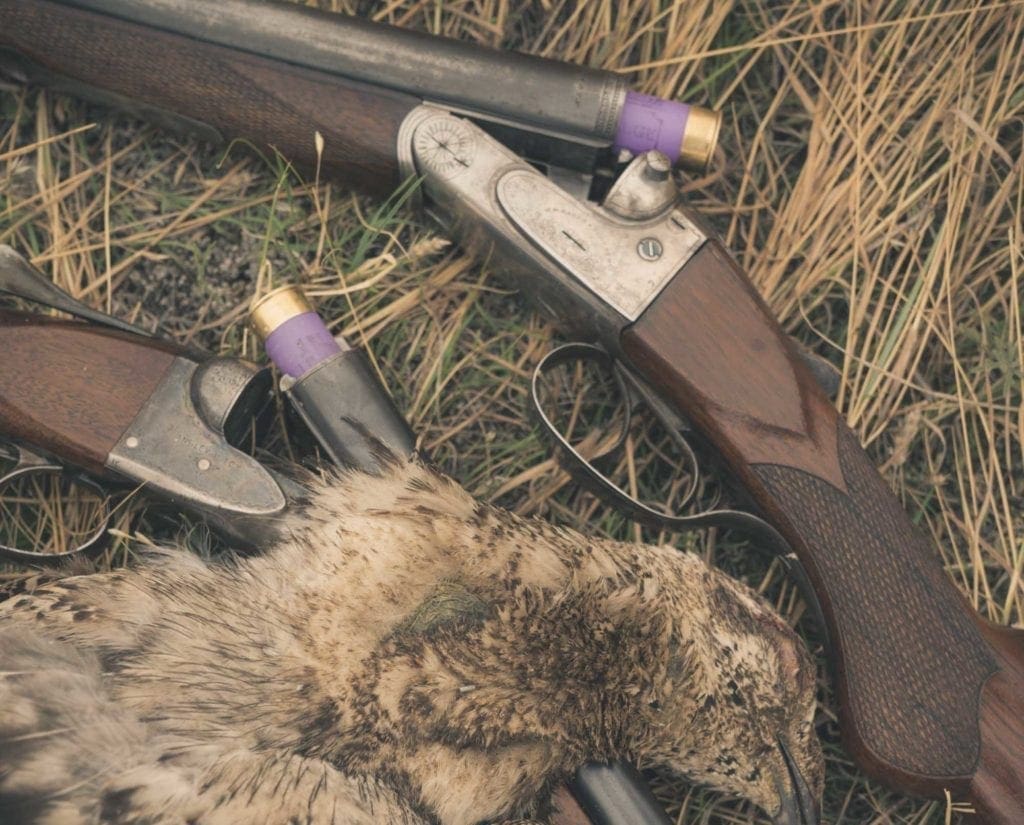
16-Gauge Bore Diameters
| Cylinder | .662” |
| Skeet | .658″ |
| Improved Cylinder (IC) | .665″ |
| Light Modified (LM) or Skeet II | .652″ |
| Modified (MOD) | .647″ |
| Improved Modified (IM) | .642″ |
| Full | .633″ |
The 16-Gauge Load and Ammunition
During the advent of the modern shotgun in the late 1800s, the standard 16-gauge load was 2 ½ drams, 1 oz shot, with a 2 ½ cartridge length. Today, both 1 oz and 1 ⅛ oz 2 ¾” loads are commonly found at gun shops. Despite what some people may tell you, the standard 1 oz 16-gauge load is not a “square load.” The discussion of “square loads” is more accurately a discussion between length and diameter ratio of the shot column in a load. Note that this differs from the black powder ratio, which accounts for both powder and shot.
Walking into your local sporting goods store and finding a box of 16-gauge shells was a rarity not five years ago; now, Walmart sells them along with most other ammo retailers. According to Cabela’s website in May of 2023, the store offers 12 types of 16 gauge ammo (not including shot size). In contrast, they offer 83 options for 12 gauge and 37 options for 20 gauges.
Regarding sub-gauges, the 16-gauge is by far the best patterning load. The L/R of a 16-gauge load is 1.41. Comparable, the 20-gauge is 1.68. Pattern efficiency is about seven percent greater than the 20-gauge and about nine percent better than the 28-gauge.
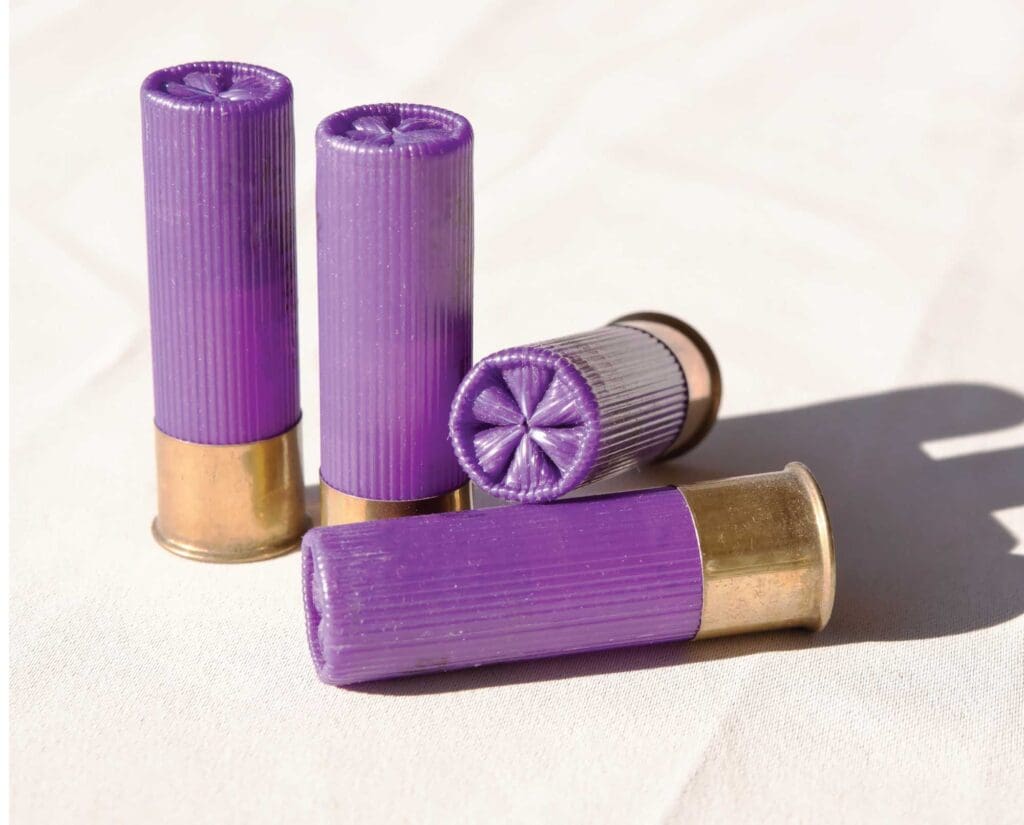
Using 1 oz. Federal Game Loads as a baseline for lead ammunition, a box of No. 6 16 gauge shells comes in at $20.99. That’s eight bucks more expensive than the 12-gauge equivalent, which is about $0.30 more per round. The velocity (FPS) comes in at 1165 compared to the 12-gauge’s 1290.
One of the greatest disadvantages of the 16-gauge is certainly ammunition selection. You can expect to pay a lot more when shopping for steel shot. Federal Speed Shok #2 comes at $37.99 for 16-gauge loads compared to the same ammunition for the 12-gauge at $20.99. Luckily, Kent Bismuth prices do not fluctuate as much as steel. 16-gauge #5 Kent Bismuth comes in at $59.99 versus its 12-gauge counterpart at $53.99.
Three-inch shells are virtually nonexistent for the 16-gauge. Some folks, myself included, would argue that’s a good thing. Remember our discussion of the length/diameter ratio? A 3” shell means more shot is packed in, resulting in pattern deformity and inferior patterns.
Modern Built 16-Gauge Shotguns
Just a decade ago, people were writing articles about the decline of the 16-gauge; that’s no different than what W.W. Greener wrote in 1897. However, these writers provide evidence that the 16-gauge’s popularity depending on performance, nostalgia, or a little of both, is timeless. The gauge has some handicaps; for example, it’s not recognized in skeet classes. Additionally, the cost of ammunition is high in some cases, yet the gauge still carries on. Despite these disadvantages, modern shotgun manufacturers have embraced the trend and increased the availability of 16-gauges.
Best Side-by-Side 16-Gauge Shotgun Models
The 16-gauge is most popular in the form of side-by-side shotguns. There is no doubt the side-by-side renaissance has helped its case. From vintage side-by-sides to modern builds, there are some great options to get into 16-gauges at various levels.

The Upland Gun Company RFM Custom Built Zeus 16-Gauge
Most shotgun enthusiasts are not used to seeing the words “custom built” alongside affordable price tags like the Upland Gun Company Zeus. This Italian-built 16-gauge side-by-side starts at $1,999. It’s built to your measurements with fixed chokes you get to choose from, mono-bloc barrels, double triggers, a pistol grip, and a coin finish. The add-on options are endless, although the base build is a wonderful shotgun. You can add a straight stock for $200 and your initials for only $150. Change to a single trigger, or maybe upgrade the wood; many options exist.

The Upland Gun Company RFM Custom Built Venus 16-Gauge
Starting at $3,299, Venus 16-gauge comes in at six pounds, making it a fine grouse gun for those looking to shave off every ounce. Like the Zeus, it comes built to your dimensions, with the base model having an English straight stock.

CZ Sharp-Tail 16-Gauge Side-by-Side Shotgun
Although CZ USA no longer lists the CZ Sharp-Tail 16-gauge as being in production, it is still available in many locations. They are becoming increasingly difficult to find, but they hover around $1,099 when you can find one. The 28-inch barrel, single trigger, pistol grip 16-gauge comes in at 7.3 pounds.
While you might be saving money initially, overall, you will pay for this purchase in both weight and long-term performance. I have had issues with the safety loosening and firing pin issues, but that was after shooting a solid thousand rounds. However, it’s something to remember based on how much you expect to use your CZ Sharp-Tail.
Best Over-and-Under 16-Gauge Shotguns
From the Stevens 555 to the Franchi Instinct line, the 16-gauge gets plenty of love in the over-and-under realm as manufacturers offer various price and quality levels to those hunting for their next 16-gauge shotgun.

Stevens 555 16-gauge Over/Under Shotgun
The Stevens 555 16-gauge was a big hit when it was first released. The Silver model starts at $749.99, followed by the Stevens 555 E at $849.99. The Silver comes in at 6 lbs, 6 ounces. The Stevens 555 E 16-gauge shotgun comes in at 6.45 lbs. Both are advertised as ambidextrous and chambered for 2 ¾” rounds. For those looking for the most affordable 16-gauge over/under shotgun, the Stevens 555 is the way to go.

Franchi Instinct 16-gauge Over/Under Shotguns
I have a soft spot for the Franchi Instinct line. It was the first over/under shotgun I bought and the only one I have not sold off. Coming in at 5.8 lbs, the Franchi Instinct SL makes for an excellent grouse gun. With an MSRP of $1,799, it is more expensive than the Stevens, but the overall quality of this shotgun is higher. The 16-gauge is also available in the Instinct Sideplate model (MSRP $2,399) and the Instinct SLX (MSRP $2,249).

The Upland Gun Company RFM Built Sk Field Over/Under 16-gauge Shotgun
Upland Gun Company released their over/under options in 2022. The SK Field is custom-built to your measurements and has many custom options. The base model comes in at $2,199 and can even have two triggers when you build it online. The shotgun weighs roughly 6.5 lbs in the 16-gauge option and can be a great upland hunting shotgun with endless custom options.
Best Semiautomatic 16-Gauge Shotguns
The availability of 16-gauge shotguns is most limited regarding semiautomatic actions. Browning is the dominant manufacturer of a semiauto 16-gauge. However, TriStar offers an affordable, entry-level option. Interestingly enough, one could argue the most recent revival of the nostalgic 16-gauge shotgun has been driven by the Browning A5 “Sweet 16” that won over the generation that missed the 16-gauge shotgun hay day.

Browning A5 Semiautomatic 16-Gauge Shotgun
Coming in various options, the Browning A5 16-gauges start at $1,679.99 and go as high as $2,149.99, based on which of the A5 “hump back” models you are interested in. Some models weigh under six pounds, and others are roughly over that mark. From classic wood finishes to various camouflage patterns, many options are available. The Browning A5 is most known for its recoil-operated Kinematic Drive System. Their recoil-operated shotguns dominated the market before the Italian-built Inertia designs took over.

TriStar Viper G2 Semi Automatic 16-gauge Shotgun
In contrast to the Browning A5, the TriStar Viper G2 is built as a gas-operated action and weighs 6.5 lbs. Coming in at an MSRP of $639, the TriStar is known for its entry-level prices. As a result, one can expect to sacrifice performance, and I would be wary of anyone looking for heavy use of this 16-gauge shotgun model.

16-Gauge Pump Shotgun Options
The only modern large production 16-gauge pump shotgun is the Browning BPS. Weighing 7.1 lbs, the Browning BPS 16-gauge starts at an MSRP of $729.99. If vintage pump guns are your thing, the Winchester Model 12 and the Ithaca Model 37 are worthy 16-gauge shotguns. One can expect to pay a wide range of prices based on the condition, but they are frequently available.
Looking Back on the 16-Gauge Shotgun in History
I assumed the 16-gauge was very popular at some point in history. I dug as far back as the London Gun Trials of 1879, and the 16-gauge never surpassed the 12-gauge in popularity. Sure, it enjoyed times of more significant popularity, but there was never a moment that set it well ahead of the 12-gauge. Curiously, in those very trials, the final “figure of merit” on the best shotgun made was, in fact, a 16-gauge with a score of 266.52 points. This score was calculated using a combination of patterns, pattern deviation, recoil, and velocity. The 20-gauge beat out the 12-gauge by only 1.68 points.
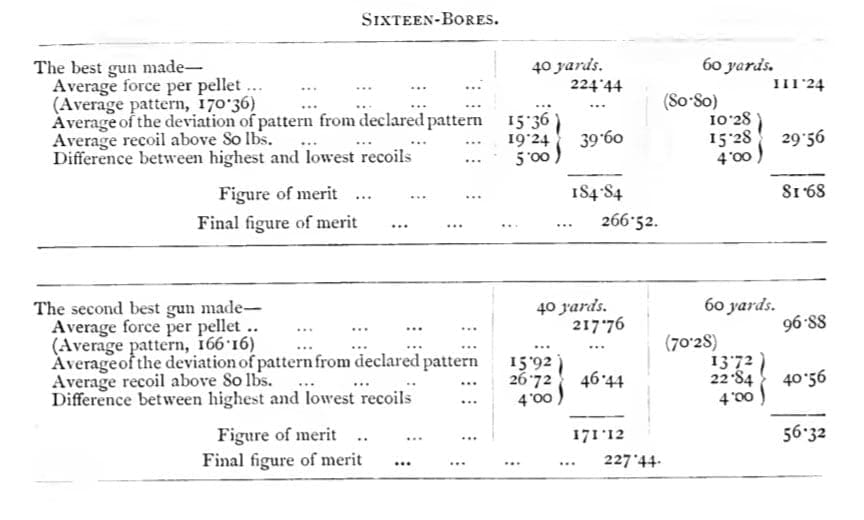
In W.W. Greener’s 1897 book The Gun and its Development, he writes, “The 16-BORE GUN was at one time a favorite with Continental sportsmen, who now for the most part, prefer the 12-bore; for use in England probably not one gun in five hundred is made 16-bore.” It’s also important to note the lack of popularity of the 20-gauge at that time: “The 20-BORE has been strenuously advocated by writers in the sporting papers, but there are very few sold — the proportion is perhaps one 20-bore to twenty of 16-bore,” wrote Greener.
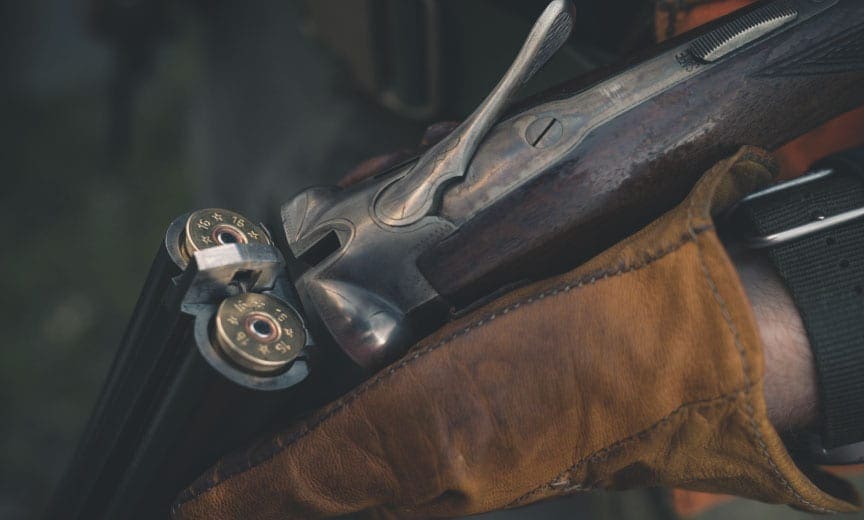
In Modern Shotguns, Greener wrote that “a 16-gauge with 3o-inch barrels may weigh 6 ¾ lbs, and be made a powerful weapon, but 6 ½ lbs, is the full average weight; if with 28-inch barrels 6 ¼ or even 6 lbs. ; with 25-inch barrels, and built as a miniature gun, 5lbs. 2 ozs.”
Although I do not see any 16-gauges staying in my gun safe past my great grandfather’s Belgium guild hammer gun, that does not mean it’s a bad gauge. Truthfully, my small frame is better suited to 20- and 28-gauges. But what doesn’t work for one person might work for another. If you can shoot it straight and find shot shells, enjoy hunting and shooting with your 16-gauge. I’m sure we’ll be hearing about a rise in the popularity of 16-gauge shotguns again.
A.J. DeRosa, founder of Project Upland, is a New England native with over 35 years of hunting experience across three continents. His passion for upland birds and side-by-side shotguns has taken him around the world, uncovering the stories of people and places connected to the uplands. First published in 2004, he wrote The Urban Deer Complex in 2014 and soon discovered a love for filmmaking, which led to the award-winning Project Upland film series. A.J.'s dedication to wildlife drives his advocacy for conservation policy and habitat funding at both federal and state levels. He serves as Vice Chair of the New Hampshire Fish & Game Commission, giving back to his community. You can often find A.J. and his Wirehaired Pointing Griffon, Grim, hunting in the mountains of New England—or wherever the birds lead them.






The 16 may “carry like a 20 and hit like a 12” it also kicks like a 10. I recently purchased a Merkel 1620. Great gun I really like the gun with the 20 bbls. the 16 bbls. are brutal to shoot even with mild loads.
Recoil depends upon the weight of the gun, the dimensions, the type of gun, and the load of the shells you are shooting. I have a 16 gauge Fox SXS with a leather pad which only weighs 6 lbs. I shoot 1 oz or 1 1/8 oz shells and it shoots like a dream. On the other hand, I have a 20 gauge Savage single shot which kicks like a mule using only 7/8 oz loads. All things considered, gas operated guns have less recoil than double. barrels, and heavy guns absorb the energy of the recoil better than lighter guns of similar dimensions. The amount of powder in the shell makes a difference, as does the type of butt plate. A shock-eye type pad makes an incredible difference over a hard plastic butt plate.
The gun does not fit you. Have a stock fitter adjust it to fit you.
I bought a Dickenson side by side 16 about 5 years ago. I can’t tell you what it ways. This at the time was a Cabela’s brand and I bought it out of their library for just under $2,000. It’s a beautiful gun. I was leary about buying a relatively new brand at the time but seriously could not be happier with this gun. I use it for quail, chukar, blue grouse and huns, plan on using it for duck this year. I have had it up at the local skeet range and I am impressed with its capability and it’s range. This gun did not come with a buttpad but I have never needed it either. The only draw back I find with it, is that the double trigger configuration tends to be a bit of a knuckle buster. nothing a little rubber can’t fix, and really never a problem in the field. Tell you the truth, after a summer of weekly skeet shooting. my fingers hardly notice. In any case, I love the gun. I should probably start reloading to cut the cost a bit. But thanks for this article.
Markell 40e … 6lbs even SxS … with options … order from Merkel USA in Bessmer(?), Alabama. They do not advertise them in the USA. Yes $$$ ($4000+) but not as costly as the 1620 mentioned. That 1620 mentioned is REALLY nice … low pressure light loads tame it. 16’s are for 1oz loads or less. 1200 FPS is enough, then the kick is no problem. The 1 1/8 loads and higher velocity loads are not necessary for most upland. Those are optimal 12 ga loads. Get some of the 16 ga. 2 1/2 in. or 2 3/4 in. loads with low pressure and sixteens are indeed “sweet”. 1 1/8 oz at 1423 FPS is a load for heavier gun, a 12 ga load for a 7lb. plus gun. Or perhaps to cycle a semi-auto.
I have a Baker, Batavia Leader, and two Remington Model 11’s. I totally agree with your load assessment!
For decades I’ve carried an Arrieta SLE in 16-gauge, and a Merkel 1620. Both guns weigh in just a bit over 6-pounds and are a joy to carry. Shooting one-ounce loads of 7 1/2 shot at around 1200fps or a bit less these guns are also a joy to shoot. Nostalia combined with effectiveness. Win-win,
I’ve been shooting a Beretta lightning feather for 10+ years. Love hunting with it but I can’t make it through a box of shells at the range without starting to flinch… Even tried 2 1/2 ” shells. Just too light of a gun. Have the same issue with my Upland Ultralight 12 ga CZ and 3″ shells.
Have any of you tried the RST. Lites? I shoot the 2 1/2″ – 1 oz. loads in #7 shot for pheasants &# 8’s for grouse & woodcock, they are very efficient and light kicking. Oh, by the way, I shoot them out of a J.P. Sauer hammer gun made in 1885 with fluid steel barrels that tips the scales at 6 lbs.(gunsmith approved). Most of my other (13) doubles are now in semi-retirement.
I love the sixteen. I butchered far too many rabbits with the twelve in my youth. I have several prewar old German examples, all in 2 1/2 inch chambers. I too bought RST shells. I also reload and here there is no difference in price or difficulties. I too have a hammer Sauer & Sohn made in 1896. Talk about light! I use the Falcon Light load.
I forgot to mention the Sauer is a 16 gouge.
Browning also makes limited runs of the Citori O/U in 16ga almost every year. This is on a true scaled 16 frame. Rizzini has scaled 16ga offerings in numerous offerings, including the BR110 and Aurum. The idea that a 16 somehow kicks worse than any other gauge is just downright ignorant. Just like any other gauge, the gun fit, weight, and load dramatically affect recoil.
I completely agree. I shoot 2 model 21’s, 2 Belgian made A 5’s , 2 citori’s, a model 12, and a Remington 870. All work well on early season wild birds. For late season wild birds I use 12 gauges. For those who dislike the perceived recoil of commercial shot shells, they can load their own ammunition. Ballistic Products sells all necessary components as well as a 16 gauge reloading manual.
Tri Star markets a nice 16ga O/U. Not too pricey.
I have the Tristar 16 gauge. Love it. Just left Maine where I shot a bunch of grouse, woodcock and a few Hares with it.
I also own the Ithaca Featherlite in 16 Gauge which I also love. I have no problems with the kick of either gun. Not to sure what everyone is talking about.
Could be that they bought a cheap gun. That’s what it sounds like to me. What they bought wasn’t well made. Now that I have a brand new Browning sweet 16, my “nice” tristar g2 viper 20ga feels like crap. I looked at that Savage 555E and though it’s priced right, I’m thinking there’s a quality issue there (ie it’ll be the same as my Tristar). Which is why I’m not buying it. I’m lookin at a Franchi Instinct SLX 16ga . The action on that Tristar doesn’t feel nearly as good as that Browning, and I want somethin SWEET!!! My Ithaca 37 featherlight, that’s sweet. That Franchi is lookin dang sweet too. I prefer 16’s because they’re more versitle than a 12. I can use my 16s for everything.
I have owned various 16 gauge shotguns and found my favorite in the Remington 1100. It is balanced well in my hands and is soft shooting even with heavier loads. I like the Remington 1148 16 gauge as my back up gun when pheasant hunting. These are not pricey guns. Look around a bit and you can find some dandies. The Marlin Model 90 is an over/under that had 16 gauges. I had one that was light enough to carry all day. I did not get used to the double triggers. I am a semi-auto kind of guy.
I have Remingtons; Model 1100, Sportsman 48, 11-48 and Model 11, all in 16 ga. Also have a Marlin-made O/U for Sears in 16 ga. Love them all…
I hunt with two Citori’s. One weighs 7 lbs, 2 oz, and I use it for ducks, doves and clays. The other weighs 6 lbs, 6 oz and is perfect for pheasants, grouse and quail. B & P sells excellent hunting ammunition in 16 gauge on line. Ballistic Products, Corcoran, Mn. sells 16 gauge reloading components, including primed hulls.
I’ve carried my field grade LC Smith 16 for years now. It has the best swing of any gun I own. It won’t win me any skeet competitions, but neither will it quit when it’s important. Side by guns feel “right “ hanging over your shoulder.
I found a 16 ga. l.c. smith field grade made in 1941,,, i belive it was unfired or less than a box thru it! I own about 5 different 16,s love them! side x sides pumps. they are great!
Beware that older guns may be chambered for 2-1/2″ shells. Some have been bored to 2-3/4″. Good to have a gunsmith check them out. My old German 16 ga SxS is 2-1/2″. RST carries 2-1/2″ loads, but I also reload. These do fine on grouse and woodcock.
I just found an old Model 12 i16 ga in very nice shape at an even nicer price so couldn’t pass it up. Nice to have that extra round in the early season, plus can use store-bought 2-5/4″ shells.
By the way, when you mention “Sweet Sixteen” to a shotgunner, that was similar to saying “thirty-thirty” (“turdy-turdy” up north) to a rifleman. They each bring up visions of only one respective gun … the Browning A5 16ga and the Winchester Model 94 .30-.30.
My FUN Gun is the Browning Citori Feather. Even though it’s light at 5 lb. 15 oz. and has a forward balance bias (16 gauge barrels fitted to a 20 gauge alloy frame) with pedestrian grade gloss finish wood, it has earned its bona fide’s as a reliable and versatile shotgun during the past 10 years hunting:
Turkey – (B&P F2 Classic #5)
Pheasent – (Kent Fast Lead #6)
Mallards – decoyed in beaver pond- (Kent Tungsten Matrix #5)
Hungarian Partridge – (Kent Fast Lead #6)
Ruffed Grouse – (RST Lite #6)
Bobwhite Quail – (RST Lite #7)
Woodcock – (RST Lite #7)
I like that my Citori Feather has no-recoil pad (smooth snag-free mount) due to manageable recoil from the non-magnum 2 ¾” /1 oz./ ~1200 fps shot shell. Shot sizes #5, #6 and #7 covers 95% of the upland game I hunt making purchasing these common shot size shells online no more difficult than any other online transaction for other products. For me the FUN of hunting with my 16 gauge and my GSP bird dog makes is making more life long memories.
Memories that carry me through to the next season…. for 51 years and (Lord willing) counting!
Also very fond of my Browning Lighting Feather which Bill Hanus Bird Guns praised. 6-1/4 lbs w/ Pachmar’s thickest recoil pad on the uncut stock = LOP ideal for my lanky 6’4″. Acquired a Philadelphia Fox Sterlingworth a few years ago. 90% gun, original case color, built 1928 with short chambers, so it gets 2-1/2″ RST ammunition. Fits me fine with slip on leather pad. I use both for dove and quail here in CA. Considering a South Dakota pheasant expedition w/ GSP Arlo now.
Love my vintage Ithaca Model 37 and Remington Model 31 in 16 gauge. Also have a nice little Kettner German guild side by side that sure is sweet.
I sell a number of FAIR 16ga sxs its an Italian maker very nice.Also Rizzini o/u and sxs deserve a look.Browning has an o/u too.I love 16ga I have 4 🙂 Thanks Dave
I have a Parker VHE circa WWI in 16ga. w/3 inch chambers. Interesting because nobody will admit to ever having manufactured that shell. It was choked EF in the right barrel and F in the left, probably set up for pass shooting waterfowl with 32 inch pipes. I love this gun as much as any I’ve ever shot, and have taken a truckload of birds with it on Montana’s prairies.
I have model 1897 winchester pumps in 16 guage as well as 12. Both work quite well on pheasant and quail. 16 is a little lighter in weight and recoils less.
I shoot an LC Smith 16 in my old age. It’s nimble enough for birds and it will handle #1 buck for driven deer and boar.